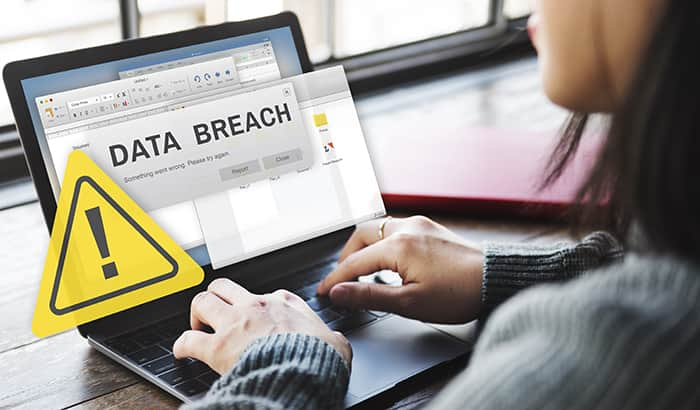
Data breaches or data leaks can be far more than a temporary terror — they may change the course of your life. Businesses, governments, and individuals alike can experience huge complications from having sensitive information exposed. Whether you are offline or online, hackers can get to you through the internet, Bluetooth, text messages, or the online services that you use.
Without proper attention to detail, a small vulnerability can cause a massive data breach.
Since many people are unaware of how common modern security threats work, they don’t give it enough attention.
In this article, we’ll explain data breaches and how they can impact you.
As we dive in, you’ll get answers to some frequently asked questions:
- What are data breaches?
- What causes a data breach?
- How does a data breach affect me?
- What can I do to prevent data breaches?
Before going further, we’ll start with a quick data breach definition.
What is a Data Breach?
To define data breach: a data breach exposes confidential, sensitive, or protected information to an unauthorized person. The files in a data breach are viewed and/or shared without permission.
Anyone can be at risk of a data breach — from individuals to high-level enterprises and governments. More importantly, anyone can put others at risk if they are not protected.
In general, data breaches happen due to weaknesses in:
- Technology
- User behavior
As our computers and mobile devices get more connective features, there are more places for data to slip through. New technologies are being created faster than we can protect them.
Devices in the IoT sector are proof that we are increasingly valuing convenience over security.
Many “smart home” products have gaping flaws, like lack of encryption, and hackers are taking advantage.
Since new digital products, services, and tools are being used with minimal security testing, we’ll continue to see this problem grow.
However, even if the backend technology was set up perfectly, some users will likely still have poor digital habits. All it takes is one person to compromise a website or network.
Without comprehensive security at both the user and enterprise levels, you are almost guaranteed to be at risk.
Protecting yourself and others starts with understanding how a data breach occurs.
How do Data Breaches happen?
The assumption is that a data breach is caused by an outside hacker, but that's not always true.
Reasons for how data breaches happen might sometimes be traced back to intentional attacks. However, it can just as easily result from a simple oversight by individuals or flaws in a company’s infrastructure.
Here’s how a data breach can occur:
- An Accidental Insider. An example would be an employee using a co-worker's computer and reading files without having the proper authorization permissions. The access is unintentional, and no information is shared. However, because it was viewed by an unauthorized person, the data is considered breached.
- A Malicious Insider. This person purposely accesses and/or shares data with the intent of causing harm to an individual or company. The malicious insider may have legitimate authorization to use the data, but the intent is to use the information in nefarious ways.
- Lost or Stolen Devices. An unencrypted and unlocked laptop or external hard drive — anything that contains sensitive information — goes missing.
- Malicious Outside Criminals. These are hackers who use various attack vectors to gather information from a network or an individual.
Malicious Methods used to Breach Data
Since malicious data breaches result from cyberattacks, you should know what to watch for.
Here are some popular methods used by hackers
- Phishing
- Brute Force Attacks
- Malware
Phishing. These social engineering attacks are designed to fool you into causing a data breach. Phishing attackers pose as people or organizations you trust to easily deceive you. Criminals of this nature try to coax you into handing over access to sensitive data or provide the data itself.
Brute force attacks. In a more brash approach, hackers might enlist software tools to guess your passwords.
work through all the possibilities for your password until they guess correctly. These attacks take some time but have become rapid as computer speeds continue to improve. Hackers even hijack other devices like yours via malware infections to speed up the process. If your password is weak, it might only take a few seconds to crack it.
Malware. Your device’s operating system, software, hardware, or the network and servers you’re connected to can have security flaws. These gaps in protection are sought out by criminals as the perfect place to shove malware into. Spyware specifically is ideal for stealing private data while being completely undetected. You might not find this infection until it’s too late.
What is targeted in Data Breaches?
Although a data breach can be the result of an innocent mistake, real damage is possible if the person with unauthorized access steals and sells Personally Identifiable Information (PII) or corporate intellectual data for financial gain or to cause harm.
Malicious criminals tend to follow a basic pattern: targeting an organization for a breach takes planning. They research their victims to learn where the vulnerabilities are, such as missing or failed updates and employee susceptibility to phishing campaigns.
Hackers learn a target's weak points, then develop a campaign to get insiders to mistakenly download malware. Sometimes they go after the network directly.
Once inside, malicious criminals have the freedom to search for the data they want — and lots of time to do it, as the average breach takes more than five months to detect.
Common vulnerabilities targeted by malicious criminals include the following:
- Weak credentials. The vast majority of data breaches are caused by stolen or weak credentials. If malicious criminals have your username and password combination, they have an open door into your network. Because most people reuse passwords, cybercriminals can use brute force attacks to gain entrance to email, websites, bank accounts, and other sources of PII or financial information.
- Stolen credentials. Breaches caused by are a major security issue and if cyber criminals get hold of this Personal information, they can use it to access things like your bank and online accounts.
- Compromised assets. Various are used to negate regular authentication steps that would normally protect a computer.
- Payment Card Fraud. Card skimmers attach to gas pumps or ATMs and steal data whenever a card is swiped.
- Third-party access. Although you may do everything possible to keep your network and data secure, malicious criminals could use third-party vendors to make their way into your system.
- Mobile Devices. When employees are allowed to bring their own devices (BYOD) into the workplace, it's easy for unsecured devices to download malware-laden apps that give hackers to data stored on the device. That often includes work email and files as well as the owner's PII.
The damage a Data Breach can do
In many cases, data breaches cannot just be patched up with some password changes. The effects of a data leak can be a lasting issue for your reputation, finances, and more.
For business organizations: a data breach can have a devastating effect on an organization's reputation and financial bottom line. Organizations such as Equifax, Target, and Yahoo, for example, have been the victims of a data breach. And today, many people associate/remember those companies for the data breach incident itself, rather than their actual business operations.
For government organizations: compromised data can mean exposing highly confidential information to foreign parties. Military operations, political dealings, and details on essential national infrastructure can pose a major threat to a government and its citizens.
For individuals: identity theft is a major threat to data breach victims. Data leaks can reveal everything from social security numbers to banking information. Once a criminal has these details, they can engage in all types of fraud under your name. Theft of your identity can ruin your credit, pin you with legal issues, and it is difficult to fight back against.
While these are common cases, the harm done by data breaches can extend far beyond these situations. So, it is essential that you investigate whether your data has already been exposed. To find out if your personal or work accounts have been compromised use https://haveibeenpwned.com/ to check (this tool checks existing data breaches for your email address and reports what was leaked).
You might want more comprehensive monitoring to know in real-time if your data has leaked. Products like Kaspersky Premium Antivirus offer data leak detection and help you navigate the situation.
Of course, the best way to protect yourself is to avoid being a victim in the first place. No security plan is perfect, but there are ways you can defend yourself — whether you’re an individual or an enterprise.
Protect Your Data – Stay Safe from Data Breaches & Leaks!
Your personal information is priceless—don’t let it fall into the wrong hands! Stay ahead of data breaches and prevent data leaks with strong passwords, encryption, and regular security updates.
Learn MoreHow to prevent being a Data Breach victim
Data breach prevention needs to include everyone at all levels — from end-users to IT personnel, and all people in between.
When you’re trying to plan how to prevent data breach attacks or leaks, security is only as strong as the weakest link. Every person that interacts with a system can be a potential vulnerability. Even small children with a tablet on your home network can be a risk.
Here are a few best practices to avoid a data breach
- Patching and updating software as soon as options are available.
- High-grade encryption for sensitive data.
- Upgrading devices when the software is no longer supported by the manufacturer.
- Enforcing BYOD security policies, like requiring all devices to use a business-grade VPN service and antivirus protection.
- Enforcing strong credentials and multi-factor authentication to encourage better user cybersecurity practices. Encouraging users to start using a password manager can help.
- Educating employees on best security practices and ways to avoid socially engineered attacks.
Related Articles:
- What to Do if Your Identity is Stolen
- Top 6 Online Scams: How to Avoid Becoming a Victim
- What is Social Engineering?
- Website Security: Is Your Business at Risk?
Related Product:


